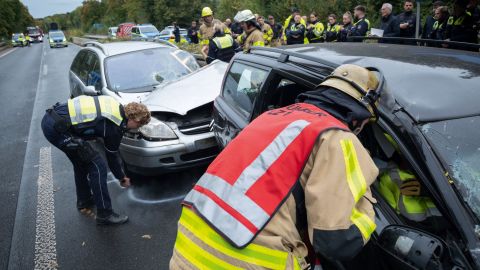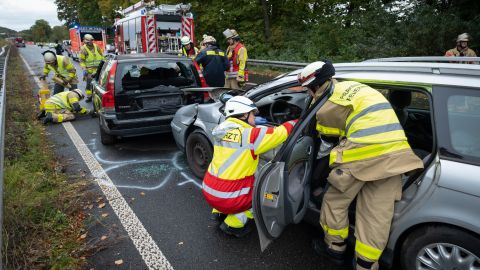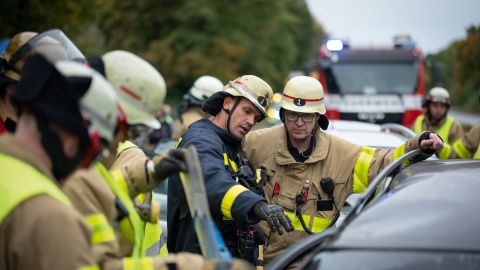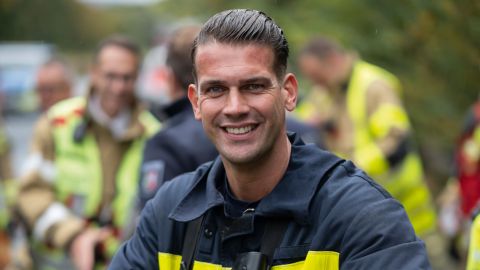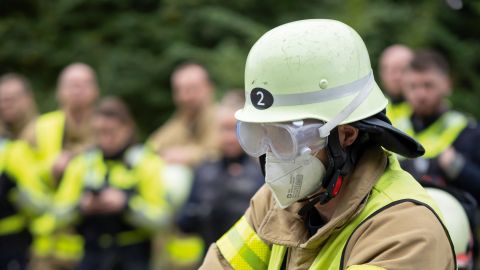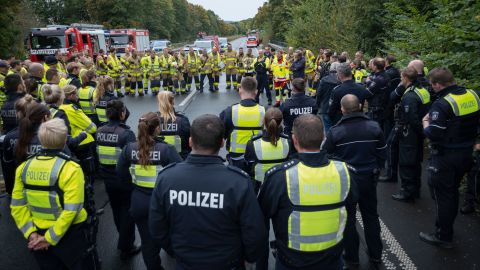The young man behind the wheel of a black Audi accelerates at Europaplatz in Aachen and turns onto the 544 freeway at a very high speed. The speedster changes lanes at top speed. After a daring overtaking maneuver, he drives onto the hard shoulder and loses control of the vehicle before the Rothe Erde junction. He drifts onto the green of the central reservation, gets asphalt under his tires again and skids back onto the road. He just manages to avoid hitting the crash barrier. But a Volvo driving behind him has to brake so hard that the Opel following behind crashes into him. Both vehicles are wrecked, the drivers trapped behind their steering wheels. They could be seriously injured. The person who caused the accident doesn't care, he makes off in his undamaged Audi.
This is the initial situation in the plot for the practical training of around 40 multipliers, who have been members of the traffic accident investigation quality circle at Cologne Police Headquarters since 2023. The aim of this team - the only one of its kind in NRW to date - is to optimize the work in this area of responsibility. "We were very happy to take the opportunity to train on the 544 freeway," says head of operations Gerhard Buse, who organized the whole thing. "An opportunity like this rarely comes along." The section of highway is closed for months due to the demolition of a bridge.
As head of the Broichweiden highway police station, Chief Superintendent Buse has a wealth of experience. He has attended many traffic accidents. For the "Multis", who bring their knowledge to the stations, it will be a great day with a variety of experiences. They come from the police stations, the highway police, the control center and the various traffic commissioner's offices. Around 30 participants from the Aachen Fire Service School also want to learn something new today. Trainers and supervisors from the police and fire department are examining the procedures down to the smallest detail.
Then the sirens sound. Patrol cars arrive before the fire department and ambulances. The police officers first close the highway to traffic and attend to the two accident victims. Some mark the final positions of the cars involved in the accident with chalk. They quickly photograph the scene of the accident from different perspectives. In this way, the colleagues from the security service create the basis for all further police measures. Speed is of the essence. Because when the fire department arrives, they need freedom of movement.
"Saving lives is always the top priority," emphasizes Fabian Golde. Securing evidence and police investigations must take second place. The head of Cologne's traffic commissioner's office 2, which deals with serious accidents, talks about the "interface problem" between the police and fire department. However, there are no irreconcilable differences. "You can always come to a reasonable agreement," says the First Chief Superintendent. "Communication is everything." And if tracks are destroyed because the fire department has to separate cars that are wedged into each other, for example, then that's just the way it is.
In the event of serious accidents, the Cologne police also send out the officers from the traffic department to support the patrol service. "We give them a few tips so that it's easier for us to investigate later," explains Golde.
In the meantime, the fire department has also arrived. The practical test picks up speed. The police have left space so that the ambulances can drive up close to the vehicles involved in the accident. The two casualties are responsive. An emergency doctor informs them that there is still a risk to life. "This is often underestimated. When someone falls into a coma, people are surprised to hear: 'We were just talking to each other,'" the doctor points out. Only the examinations at the hospital ultimately provide information about the extent of the injuries and the risks.
Meanwhile, the team of firefighters pushes blocks of wood under the accident vehicles. The "bar block system", which has been in use for a few years now, works a bit like Lego bricks. A simple and stable connection prevents the cars from moving during the rescue.
For the professional lifesavers, the question arises each time as to whether a gentler route can be chosen or whether it has to be done very quickly due to the critical condition of a victim. In the case of the driver of the Volvo, the fire department team opted for an "immediate rescue" through a side door. "We can resuscitate sooner if necessary," says Fire Chief Reiner Johnen. "However, this carries the risk of damaging the spine by turning the body."
In the case of the driver of the Opel, the rescue workers believe they have a little more time. Removing the roof is not easy. However, this allows the trapped person to be carefully lifted out of the interior of the car. Hydraulic, electronic and pneumatic instruments gradually remove the vehicle parts that are still in the way. After a good 20 minutes, it's done and the two injured people are in the ambulance, which is on its way to the nearest hospital.
Christoph Pütz, operations trainer for the Aachen fire department, "is very satisfied". His emergency crews made sure to cover the sharp edges of the demolished cars and not to pull the highly pressurized hoses through broken glass. This could cause them to burst and, in the worst-case scenario, cause the appliances to fly around your ears. Glass management" also involves pushing the windows outwards and sweeping the shards away immediately. It is very important not to set off the airbags. This is why the batteries in both cars were disconnected right at the start.
Parallel to the fire department, the police emergency services carry out their work thoroughly and in accordance with regulations. Paula Petzschke is also one of them. She likes being a member of the quality circle because she appreciates the regular training. "I want to know what to do. The practice gives me confidence." She also needs this for the training of police trainees. "Carefully securing evidence helps when analyzing the traffic accident and later when settling the claim," reports the 27-year-old police inspector.
This time, Jennifer Krystkiewicz, who is the same age, was responsible for "personal evidence". "I interviewed the people who had parked on the hard shoulder and were watching curiously." Among them were two interesting witnesses. "They had observed a black Audi that had allegedly caused the accident." The driver was still there and had mingled with the others as a rubbernecker. "I then approached the suspicious person and urgently asked them to provide information about the accident. However, she refused. That's not unusual in such cases," says the police commissioner.
Jens Buchholz from the Bensberg freeway police then joins his colleagues. The police chief inspector played the "bad guy". "Of course I denied any involvement." But plants from the hard shoulder had been found in his left wheel arch. Another indication that he caused the pile-up. Buchholz played his role convincingly: "I behaved very unsympathetically and insulted the police when they photographed and examined my car." A fictional scene that could have been taken from reality. Head of operations and organizer Gerhard Buse draws a positive conclusion at the end of the exercise: "It was nice to see how committed everyone was to the exercise."
In the follow-up, Thomas Syperrek, Head of Traffic Inspectorate 2, praised the "great work of the multipliers". The traffic accident investigation quality circle helps to further develop the standards for traffic accident investigation and processing in line with technical progress. The aim of the quality circle is to ensure high-quality traffic accident investigation and processing at the Cologne police force, says the senior police officer. The multipliers are available at all times as contact persons in the stations and carry out the further training courses at the stations with the presentations provided by the quality circle.
In the Traffic Directorate at Cologne Police, the traffic accident specialists work closely together from traffic accident recording to processing, accident analysis and safety advice through to traffic planning and monitoring. The goal is clear: they all want to ensure that significantly fewer people are involved in road traffic accidents. There are still more than 52,500 traffic accidents a year in the Cologne and Leverkusen urban region, if the highways are included. More than 30 traffic accidents ended fatally for one or more people in 2023.
"These figures make it clear that we need to act to increase road safety," emphasizes Police Chief Inspector Syperrek. Traffic Inspectorate 2 coordinates all of the traffic police departments. He considers the traffic accident recording quality circle, which was set up three years ago, to be an important step forward. With good traffic accident recording, a traffic accident can be reconstructed in detail and questions about who caused it can be clarified. Informative material also helps to defuse dangerous stretches of road.
After the actual exercise has been completed, work will continue until the afternoon on the four topics of accident photography, mono-image procedures, forensic science and securing evidence, as well as case preparation and processing.
The mono image method allows a much more precise reproduction of the traces marked with chalk than would be possible with hand sketches. This is made possible by fixed reference points - colored crosses and set up boards (so-called pointers) - which are photographed with the camera. At least five distances (the four outer sides and a diagonal) are measured from the respective reference squares using a tape measure. Computer software corrects the perspective of the photos using the reference quadrangles measured on site and finally provides an exact photographic top view. The digital tracks in the cars also support the investigation.
Of course, there is also time pressure when recording a traffic accident on the freeway, explains Gerhard Buse, who organized the exercise on the A 544. "We want a full closure to be lifted as quickly as possible. But care must not suffer as a result." The First Chief Superintendent of Police is head of the Broichweiden highway police station.
What is important when the police are recording an accident? If the evidence is well preserved, the kinetic energy of those involved in the accident can be clearly determined, including the point at which an impact occurred. Irrefutable impressions from different directions should be recorded on camera, preferably with photos and a video sequence. Objective evidence is becoming increasingly meaningful. Do personal observations, interviews and measures no longer play a role? Yes, they are still very important. The emergency services can get a good picture of the situation by skilfully questioning witnesses. They gather a wealth of impressions and can determine the driving ability of those involved, as far as the circumstances allow.
In hit-and-run accidents, the person responsible is often still concealed at the scene of the accident. Why is that? It's a bit like arsonists. They often blend in with the crowd that is watching curiously. Perpetrators are known to be drawn back to the scene of the crime.
In the event of a serious accident, saving lives takes priority. How is the collaboration with the fire department going? Basically very well. It makes sense for the police to appoint someone to maintain contact with the fire department. A safe distance must be maintained during rescue operations. This is also for our own protection.
How long did it take to prepare for the exercise? A few weeks. It was great fun, even though the organization ran parallel to my daily work. You don't do something like this every day. The idea of doing the whole thing on the highway paid off. It was a great setting and very realistic. In any case, the multipliers were pretty enthusiastic.
